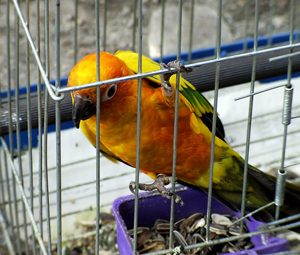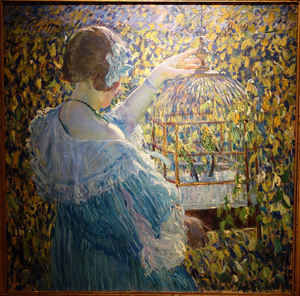
Source: Bird in cage, High Contrast, Wikimedia
In his book How to Write Best Selling Fiction, Dean Koontz defines theme as "a statement, or series of related observations, about some aspect of the human condition interpreted from the unique viewpoint of the author." In this section, you will explore the viewpoint of Paul Dunbar, one of the first influential black poets in America. You will read his poem “Sympathy,” published in 1899, which inspired the title of Maya Angelou’s autobiography, I Know Why the Caged Bird Sings, published in 1969.
Sympathy
BY PAUL LAURENCE DUNBAR
I know what the caged bird feels, alas!
When the sun is bright on the upland slopes;
When the wind stirs soft through the springing grass,
And the river flows like a stream of glass;
When the first bird sings and the first bud opens,
And the faint perfume from its chalice steals—
I know what the caged bird feels!
I know why the caged bird beats his wing
Till its blood is red on the cruel bars;
For he must fly back to his perch and cling
When he fain would be on the bough a-swing;
And a pain still throbs in the old, old scars
And they pulse again with a keener sting—
I know why he beats his wing!
I know why the caged bird sings, ah me,
When his wing is bruised and his bosom sore,—
When he beats his bars and he would be free;
It is not a carol of joy or glee,
But a prayer that he sends from his heart’s deep core,
But a plea, that upward to Heaven he flings—
I know why the caged bird sings!

Source: The Bird Cage by Frederick Carl Frieseke, c. 1910, oil on canvas - New Britain Museum of American Art - DSC09510, Daderot, New Britain Museum of American Art, Wikimedia
In the first stanza, the poet says he knows how a caged bird feels in the spring when it is denied flight over a landscape unfolding with new life. The subject of this poem is a caged bird, but Dunbar’s theme is far more reaching. Even from the first sentence, you can infer that the poet might also feel imprisoned. Dunbar is using a metaphor to imaginatively link one object (the bird) with another (a human being). A metaphor is a way to talk about one thing by describing something else. When the poet describes a bloody wing in the second stanza, you know that human beings have also suffered in captivity. In the third stanza, when you realize why the caged bird sings, you understand that it is singing a melodic prayer for freedom. Yearning for freedom is an abstract concept, difficult to wrap your head around. But you can use your senses to see a caged bird, feel the pain of old scars, and hear a desperate song.
Dunbar’s image of a caged bird resonated with Maya Angelou. Even though the slaves were emancipated at the end of the Civil War, African Americans were not able to fully participate in American life at the end of the nineteenth century when this poem was published. The time and place are relevant because they influenced the poet’s life and his thinking. Yet, a young African American girl born almost thirty years later experienced some of the same limits on her freedom. Perhaps a caged bird is a universal theme that goes beyond the context of its creation and speaks to a common human experience.
Can you think of a person or persons who might see themselves as “caged birds”?
 You might try your hand at writing a short poem using a bird as the subject. Use your notes, and click on the Check Your Understanding icon to see an example. As you write, challenge yourself to use a metaphor.
You might try your hand at writing a short poem using a bird as the subject. Use your notes, and click on the Check Your Understanding icon to see an example. As you write, challenge yourself to use a metaphor. One day I saw a kettle of hawks sitting in a newly plowed field.
There must have been fifty.
Waiting quietly and patiently.
No soaring, twisting, and falling with shrieks and talons stretched.
But waiting quietly and patiently.
In the field where all was still.
How deadly, how dangerous they were—sitting there
Waiting quietly and patiently.